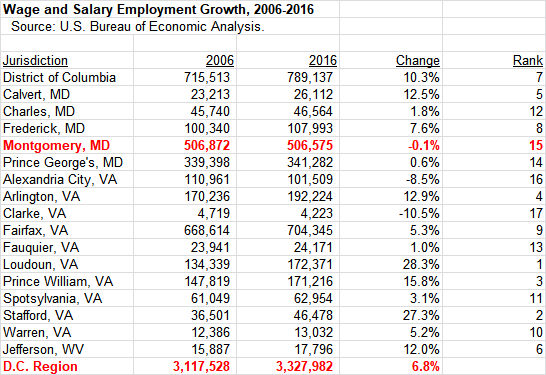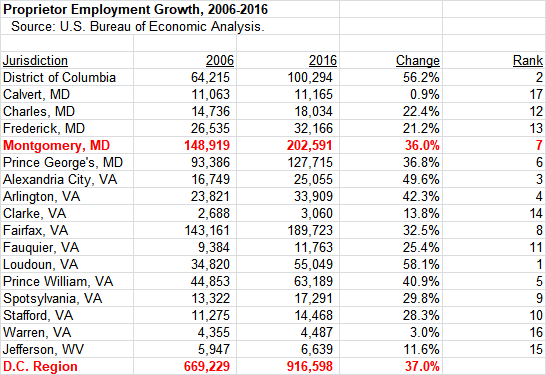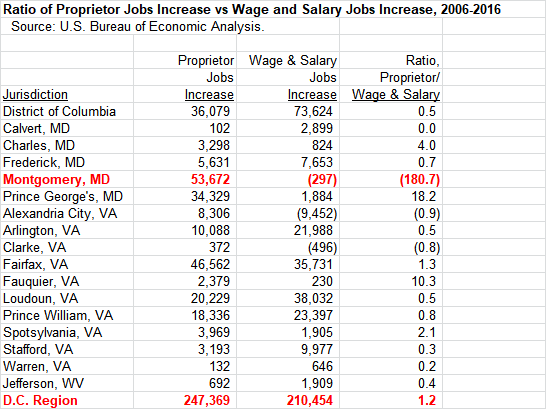By Adam Pagnucco.
Data from the U.S. Bureau of Economic Analysis (BEA) confirms something we have reported before: wage and salary employment has been stagnant in MoCo for a decade. But BEA data indicates something else is happening too: proprietor (self-employed) employment has been growing rapidly here and it pays less than wage and salary jobs. That may not be a great sign for the county’s economy.
Unlike the U.S. Bureau of Labor Statistics (BLS), which we have cited in the past, BEA tracks two kinds of employment: wage and salary and proprietors. (Check here for a summary of methodological differences between the two agencies.) Proprietors are self-employed and operate through sole proprietorships (integrated with their personal income on their income tax returns), partnerships and tax-exempt cooperatives. According to the Census Bureau’s Survey of Business Owners program, less than one in five of MoCo’s businesses have paid employees. The county has a lot of self-employed people and little is said about them.
Here is the change in wage and salary employment between 2006 and 2016 for the seventeen Washington area jurisdictions tracked by BEA.
This data tells a similar story to BLS data we have previously presented: MoCo has trailed most of the region in job creation over the last decade. Only Alexandria City and tiny Clarke County, VA have fared worse.
However, proprietor job data tells a much different story. MoCo’s rate of proprietor job creation (36% over the last decade) is almost identical to the region as a whole.
Proprietor jobs aren’t inherently bad and it’s good that MoCo has SOME kind of employment growth. But proprietors have much less security than full-time wage and salary workers. Proprietors have sole responsibility for their health and retirement benefits and many of them have little cushion when contracts and/or clients dry up. They also make less. In 2016, the average wage and salary plus employer contribution to pensions, insurance and government social insurance totaled $89,337 per wage and salary employee in MoCo. By contrast, the average earnings per proprietor totaled $66,498.
This isn’t happening just in MoCo; it’s a regional phenomenon. But MoCo is an outlier. The chart below compares wage and salary job creation and proprietor job creation by D.C. area jurisdiction between 2006 and 2016. In the region as a whole, 1.2 proprietor jobs have been created for every wage and salary job over the last decade. MoCo led the entire region in proprietor job creation with 53,672 jobs – a 36% growth rate. But MoCo was one of the worst performers in creating wage and salary jobs as one of just three jurisdictions with an absolute job loss. The result is a significant shift in MoCo away from wage and salary employment towards lower-paying contingent employment by a magnitude not seen in most of the rest of the region.
Unemployment rates don’t capture this kind of labor market shift. If a self-employed person working on contracts is not seeking a full-time job even if they would like one, that person will not be counted as unemployed.
Proprietor growth can be a good thing if it reflects job-creating entrepreneurship. That might be the case in places like Loudoun, D.C., Arlington, Fairfax and Prince William, all of which saw simultaneous increases in both proprietor and wage and salary employment. It’s possible in those jurisdictions that new proprietorships created wage and salary jobs. But MoCo is different from the above five places. Here, surging proprietorships coincided with stagnant wage and salary employment. Since proprietor jobs pay less on average, that may not be a good thing.
Let’s put this together with our previous work on the county’s economy. MoCo business formation has slowed to a halt. Private sector employers in the county have (at least through 2016) not restored their job counts above pre-recession levels. These factors have contributed to big budget shortfalls, a nine percent property tax hike and county usage of one-time transfers to balance the budget. Those MoCo taxpayers who have chosen to move out have higher incomes than those who are moving in. And in MoCo, lower paying self-employment is outgrowing higher paying wage and salary employment.
Voters, take heed.



